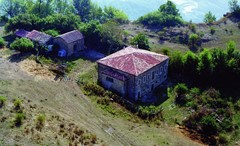Municipality of Carpineti.
The Parish Church of San Vitale
The ridge that runs from the Castle of the Carpinete to the summit of Mount Valestra takes us for a 4km walk through some delightful countryside to the archaeological site of the striking San Vitale church. On the high meadow only a few ruins remain of this ancient parish church, which once belonged to the great fiefdom of Matilda of Canossa, but is probably Byzantine in origin, like the Saint it is named after. The existence of San Vitale, described as a basilica, was already mentioned in a document from 857 and later indicated in an Imperial map of 980. It was subsequently rebuilt in 1105 and reconsecrated. The building followed an unusual basilica plan that included three naves, with the one in the middle projecting further than the lateral ones. The apses were semicircular and separated by two colonnades. The church was abandoned around the mid-XVIII century, and the religious services transferred to the Church of Santa Caterina lower down, along with San Vitale’s ancient altar. Five small niches arranged in the form of a cross on the surface of the altar housed important reliquaries. It has only been possible to recover two small, very old glass vases of enormous historical and artistic value, containing traces of textiles and fragments of wood.
Demolished by order of the Bishop in 1754, all that currently remains visible are the narthex, turned into a chapel in the 1930s, and a short stretch of the southward-facing perimeter wall. The narthex, a sort of vestibule that linked the naves with the outside of the church, and a much-used architectural element in Romanesque churches and early Christian basilicas, still retains its original quadrangular portal. Flanked by sandstone semi-columns with capitals, it is surmounted by a decorated lunette featuring a carved interwoven band.
The most prized and significant decorations were dispersed among various parishes and museums in Reggio Emilia and the nearby Apennines. It is worth noting that, around Reggio, no ancient church possesses a set of carved artefacts from so far back in time and covering such a range as San Vitale does. These items produced in local sandstone or marble, show the remarkable skill of the craftsmen employed to decorate the church, over a long period from the VII to the XII century, above all the 13 capitals made by masters from the city of Campione who were at work in Modena cathedral somewhere around 1170.
In front of the church’s antique portal lies another square building, whose style dates it back to the XVI-XVII centuries, originally used as the rectory, which is now home to priceless sculpted works, conceivably belonging to the pre-Romanesque church.
